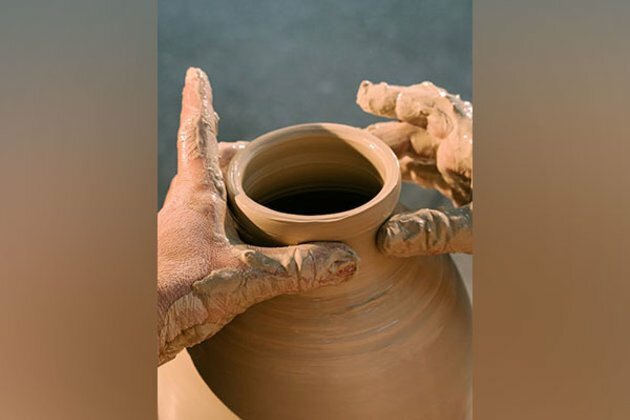Pottery colours tell a lot about power of empires: Study
ANI
18 Mar 2023, 23:57 GMT+10

Chicago [US], March 18 (ANI): Our use of colour to express who we are, where we come from, and what matters to us plays a significant role in our daily lives. Archaeologists have compared the hues on various pieces of prehistoric Peruvian pottery in a study published in the Journal of Archaeological Science: Reports. They discovered that ceramics used in ceremonies were made by potters all over the Wari empire using the same rich black colour, demonstrating the empire's influence.
The Wari empire spread over Peru's highlands and coastal areas from 600-1050 CE. "People sometimes think of the Inka as the first big empire in South America, but the Wari came first," says Luis Muro Ynonan, the study's corresponding author and a research associate and former postdoctoral scientist at the Field Museum in Chicago.
The Wari didn't leave behind a written record (or at least a system similar to the one we use now). "Since they didn't use writing, material culture -- things like pottery -- would have been an important means for conveying social and political messages," says Muro Ynonan. "The visual impact of these objects would have been super powerful." Even little details, like using the correct shade of a colour, could help signify an object's importance and legitimacy as a part of the empire.
"I remember seeing some of these Wari-influenced pots as an undergraduate archaeology student in Peru, they're fascinating," says Muro Ynonan. "The rich black colour on them is very distinctive, I've been obsessed with it for years." Muro Ynonan finally got to pursue his interest in pigment in-depth during his postdoctoral position at the Field Museum.
He and his co-authors, including Donna Nash, an adjunct curator at the Field and associate professor and head of anthropology at the University of North Carolina Greensboro, examined pottery from different regions under Wari influence, focusing on the chemical makeup of the black pigment used.
The exact formulation of pigments varied from site to site, but overall, there was one striking similarity: many of the Wari pots examined in the study used black pigment made from minerals containing the element manganese.
"Some of the sites, specifically in northern Peru, used a different recipe for black, using iron- and calcium-rich minerals before the Wari arrived, but after the Wari took over, they switched to the manganese-based recipes," says Muro Ynonan. The shift makes the authors suspect that the Wari empire asserted some sort of "quality control" over the pottery produced in different regions, perhaps even supplying artisans with the "correct" black pigment. "In general, black minerals are relatively easy to obtain from the valleys we looked at," says Muro Ynonan. But just any old black mineral didn't fit the official Wari look -- instead, he thinks that artisans may have been supplied with the manganese-bearing minerals from the Wari capital to produce the right shade of black.
The changes in hue are subtle, but Muro Ynonan says that the symbolic meaning of using "Wari black" may have been very important. "In general in the Andean region, the colour black is related to the ancestors, to the night, to the passage of time. In Wari times, the colour was likely important for imposing a specific Wari ideology to the communities they conquered."While the colours on Wari pottery might indicate imperial control, the ceramics from different regions do maintain their own local character. "Local potters had a lot of flexibility in producing hybrid material culture, combining the Wari imperial style and decoration with their own," says Muro Ynonan. The ceramics were unified by the use of black pigments that were controlled and put in circulation by the Wari empire through its imperial trade channels, but from there, artists could put their own spin on their work.
"One thing I hope people will take away from this study is that every beautiful artefact you see in a museum was made by real people who were very intelligent and possessed specific technologies to achieve their goals," says Nash, co-author of the study. "Further, these people shared technologies and made choices. Artisans talked to each other and learned from each other, but sometimes multiple ways of doing things, such as creating black lines and decoration on a decorated pot, co-existed. These different approaches to the same problem may have persisted because of wealth or class differences, but it may have been that some people were willing to try new things, while others preferred their traditions." (ANI) Share
Share
 Tweet
Tweet
 Share
Share
 Flip
Flip
 Email
Email
Watch latest videos
Subscribe and Follow
Get a daily dose of Raleigh Times news through our daily email, its complimentary and keeps you fully up to date with world and business news as well.
News RELEASES
Publish news of your business, community or sports group, personnel appointments, major event and more by submitting a news release to Raleigh Times.
More InformationBusiness
SectionTech stocks slide, industrials surge on Wall Street
NEW YORK, New York - Global stock indices closed with divergent performances on Tuesday, as investors weighed corporate earnings, central...
Canada-US trade talks resume after Carney rescinds tech tax
TORONTO, Canada: Canadian Prime Minister Mark Carney announced late on June 29 that trade negotiations with the U.S. have recommenced...
Lululemon accuses Costco of selling knockoff apparel
Vancouver, Canada: A high-stakes legal showdown is brewing in the world of athleisure. Lululemon, the Canadian brand known for its...
Shell rejects claim of early merger talks with BP
LONDON, U.K.: British oil giant Shell has denied reports that it is in talks to acquire rival oil company BP. The Wall Street Journal...
Wall Street extends rally, Standard and Poor's 500 hits new high
NEW YORK, New York - U.S. stock markets closed firmly in positive territory to start the week Monday, with the S&P 500 and Dow Jones...
Canadian tax on US tech giants dropped after Trump fury
WASHINGTON, D.C.: On Friday, President Donald Trump announced that he was halting trade discussions with Canada due to its decision...
North Carolina
SectionU.S. Senate narrowly passes One Big Beautiful Bill with huge deficit implications
The U.S. mega-bill would add about 3.3 trillion dollars of deficit in the next decade, higher than the 2.8 trillion dollars of deficit...
"Elon may get more subsidy than any human being in history": Trump hits out at Musk, EV mandates
Washington [US], July 1 (ANI): US President Donald Trump on Tuesday (local time) reiterated his opposition to electric vehicle (EV)...
"Important for Joff to be around the group this week": England skipper Stokes on Archer's inclusion in squad
Birmingham [UK], July 1 (ANI): Ahead of England's second Test against India at Birmingham, England skipper Ben Stokes spoke on express...
Musk slams Trump-backed Senate bill as 'utterly insane and destructive'
Washington [US], June 30 (ANI): Tech billionaire Elon Musk strongly criticised President Trump's 'big, beautiful bill,' calling it...
Roundup: Trump's tax and spending bill faces Democratic resistance, GOP divisions as Senate debate begins
GOP leaders are determined to advance Trump's signature agenda. But the bill's complexity, internal party fractures and Democratic...
Archer to feature for England at Edgbaston? Rob Key teases return of "world-class" speedster against India
London [UK], June 28 (ANI): ECB managing director of men's cricket, Rob Key, dropped a subtle hint about tearaway Jofra Archer's return...













